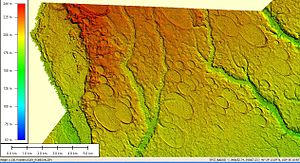
Carolina bays are elliptical to circular depressions concentrated along the East Coast of the United States within coastal New York, New Jersey, Delaware, Maryland, Virginia, North Carolina, South Carolina, Georgia, and north Florida.[1][2][3] In Maryland, they are called Maryland basins.[4] Within the Delmarva Peninsula, they and other coastal ponds are also called Delmarva bays.[5]
The name "Carolina bay" is sometimes attributed to the writings of the English explorer John Lawson who explored North Carolina, South Carolina, and Georgia during the early 18th century. This attribution, however, is not correct. Lawson described visiting a swamp that contained bay trees, but there is no indication that he wanted to name the swamp with the word "bay".[6] Furthermore, Lawson said that this swamp had steep margins and that he could see mountains to the west from the vicinity of the swamp. Thus, it seems more likely that this swamp was an inter-dune depression among the Carolina Sandhills, rather than a Carolina bay. Nevertheless, bay trees are present in some Carolina bays.[7]
The earliest scientific description of Carolina bays is by Glenn (1895), who used the term 'bay' (which he described as "lake-like expanses") to refer to these features near the town of Darlington, South Carolina.[8] Glenn (1895) put quotation marks around the word "bay" but he did not use the phrase "Carolina bay." A subsequent publication by Melton and Schriever (1933) used the phrase: The Carolina "Bays" (with quotation marks around the word "Bays").[9] Later, MacCarthy (1937) published a paper entitled "The Carolina Bays" and he used this phrase throughout the publication (without quotation marks, and with a capital "B" for the word "Bays").[10]
- ^ Cite error: The named reference
Prouty1952awas invoked but never defined (see the help page). - ^ Kaczorowski, R. T. (1977) The Carolina Bays: a Comparison with Modern Oriented Lakes Technical Report no. 13-CRD, Coastal research Division, Department of Geology, University of South Carolina, Columbia.
- ^ Gill, Gloria (24 March 2013). "Occurrence of Carolina Bays on Long Island" (PDF). SUNY.
- ^ Cite error: The named reference
RasmussenOthers1955awas invoked but never defined (see the help page). - ^ Coleman, D. (2001) Delmarva Bays: Natural Enigmas. Archived 2008-09-16 at the Wayback Machine Maryland Department of Natural Resources Archived September 3, 2013, at the Wayback Machine, Annapolis. Maryland.
- ^ Lawson, J., A New Voyage to Carolina [ISBN missing][page needed]
- ^ Sharitz, Rebecca R. (2003). "Carolina bay wetlands: Unique habitats of the southeastern United States". Wetlands. 23 (3): 550. doi:10.1672/0277-5212(2003)023[0550:CBWUHO]2.0.CO;2. ISSN 0277-5212. S2CID 19954348.
- ^ Glenn, L. C. (1895). "Some Notes on Darlington (S. C.), 'Bays.'". Science. 2 (41): 472–475. Bibcode:1895Sci.....2..472G. doi:10.1126/science.2.41.472. PMID 17796996.
- ^ Melton, F. A.; Schriever, William (1933). "The Carolina 'Bays': Are They Meteorite Scars?". The Journal of Geology. 41 (1): 52–66. Bibcode:1933JG.....41...52M. doi:10.1086/624004. S2CID 140175406.
- ^ Maccarthy, G. R. (1937). "The Carolina Bays". Geological Society of America Bulletin. 48 (9): 1211–1225. Bibcode:1937GSAB...48.1211M. doi:10.1130/GSAB-48-1211. S2CID 130189967.